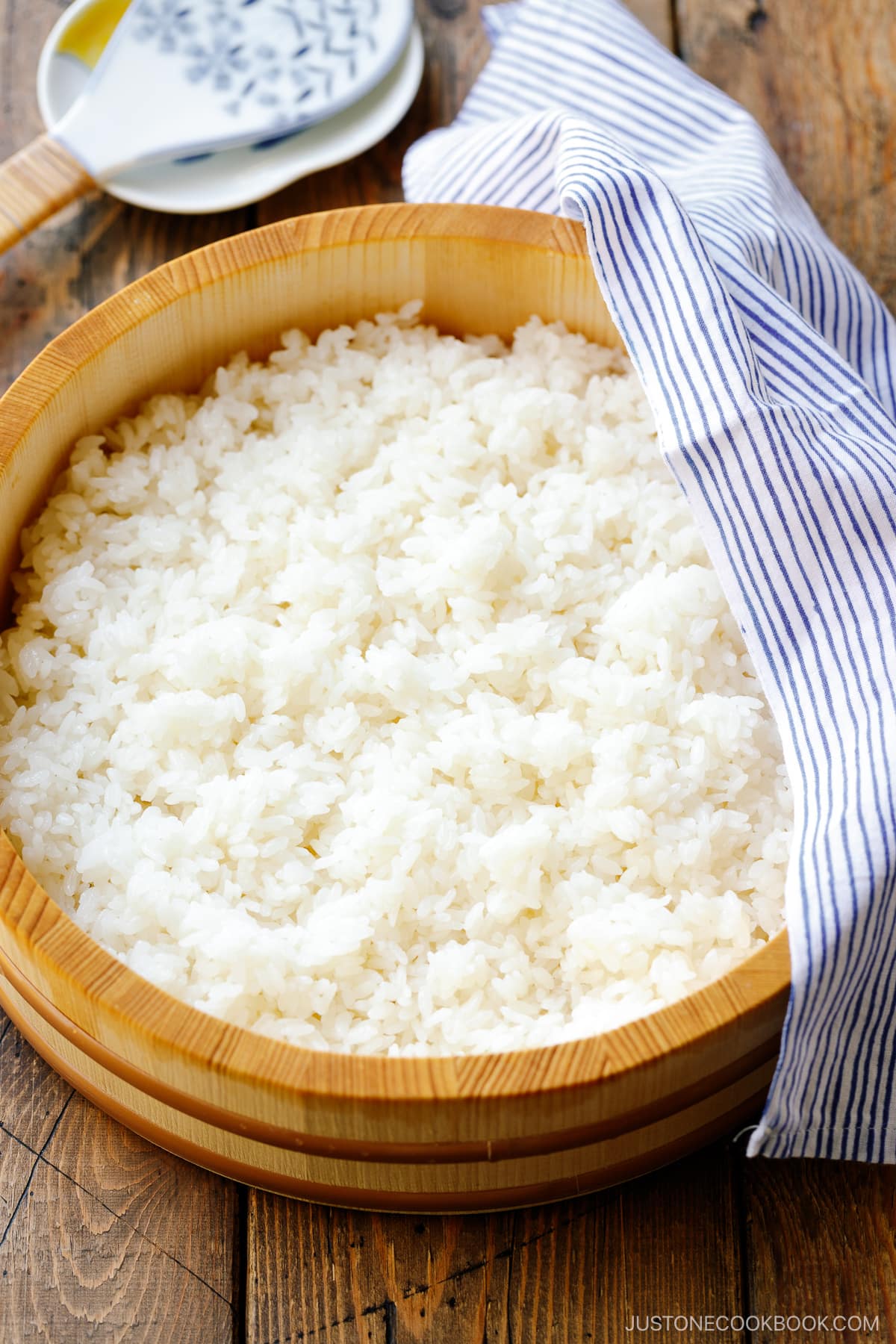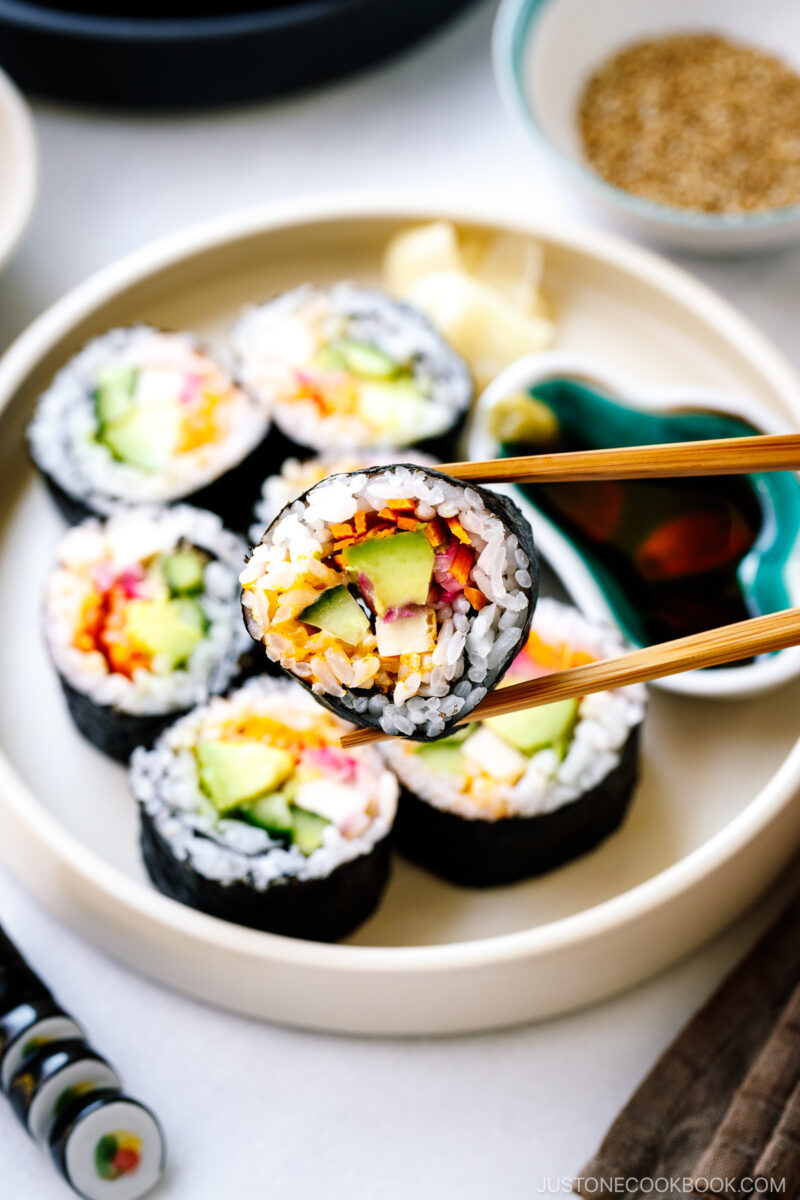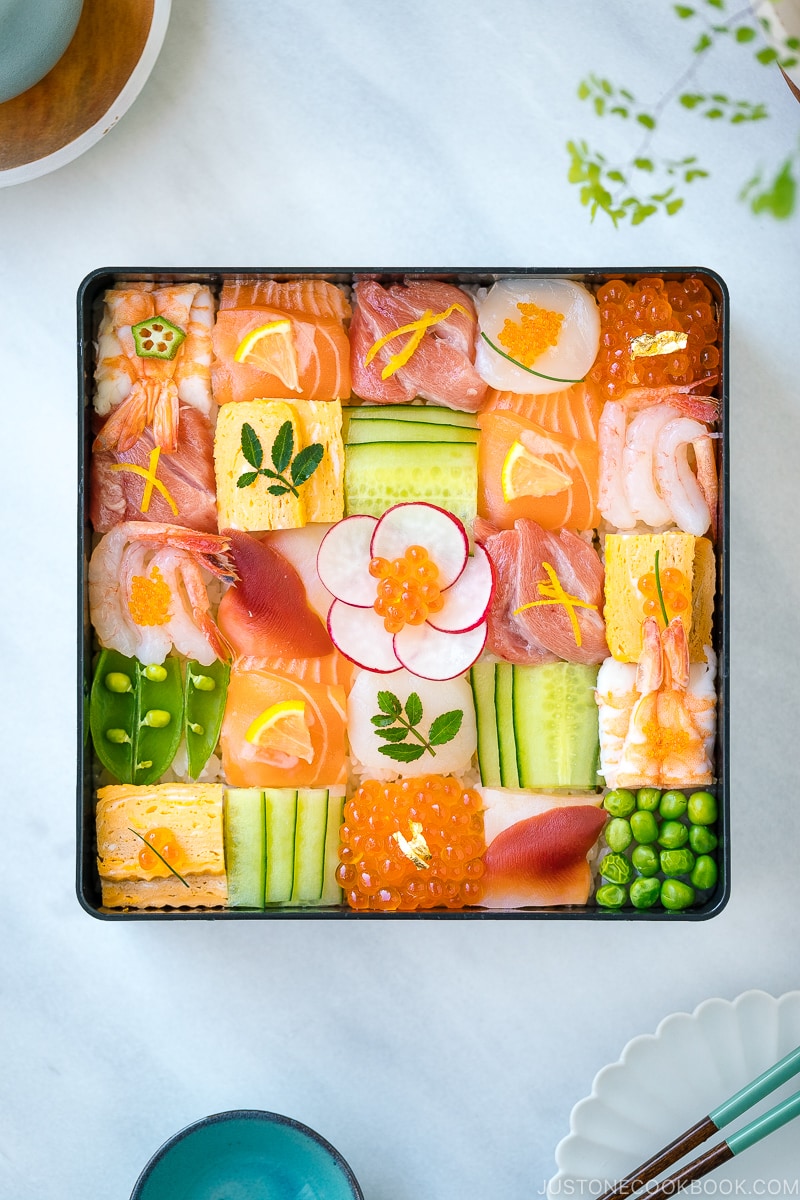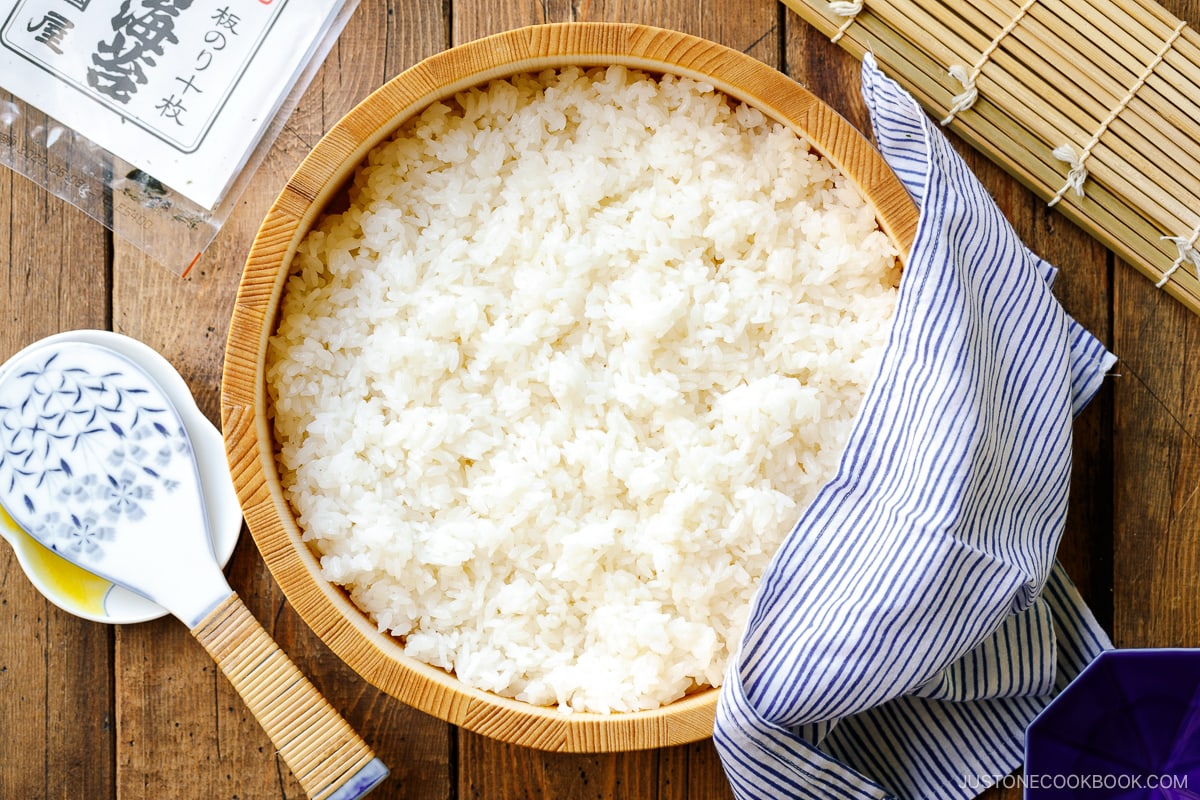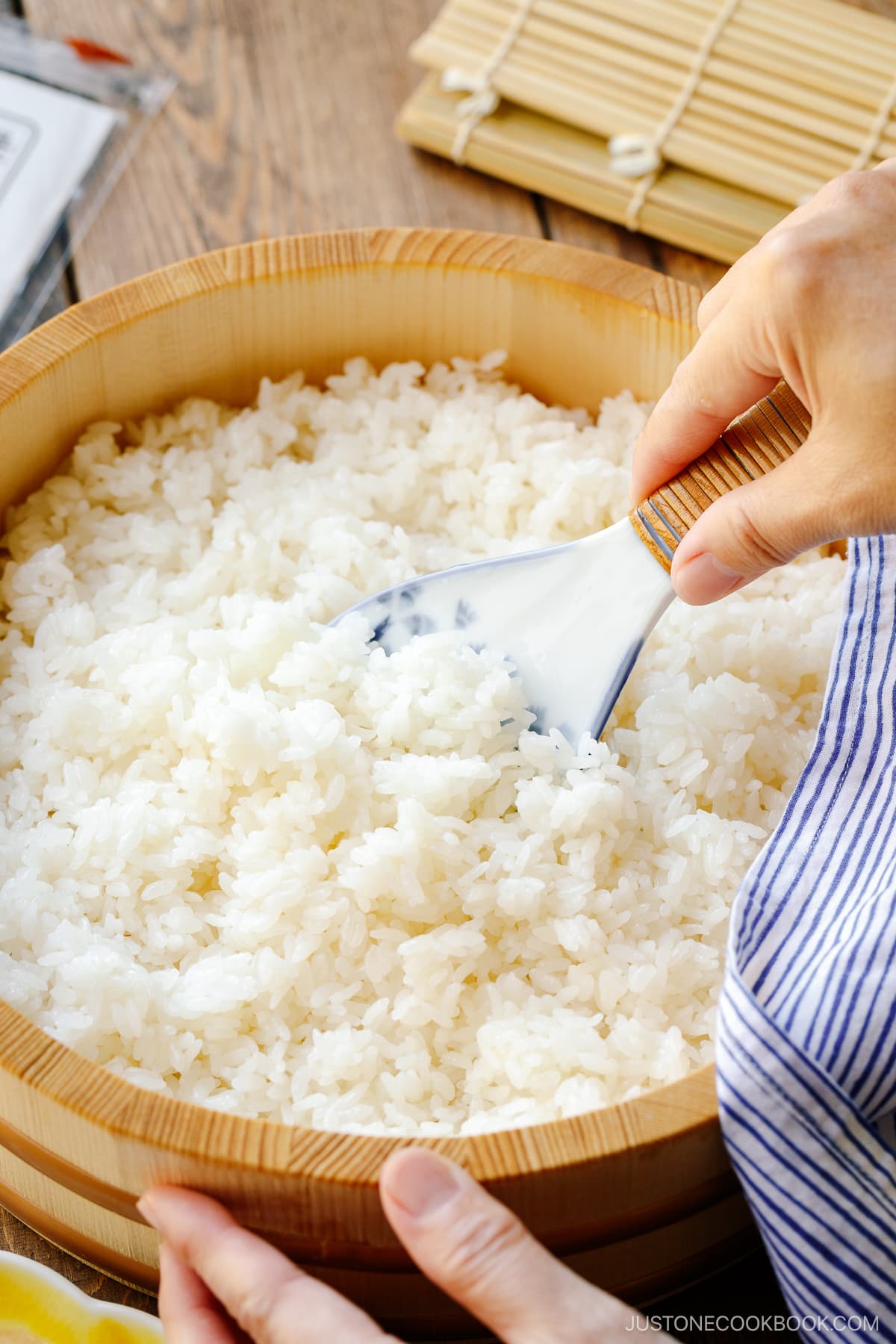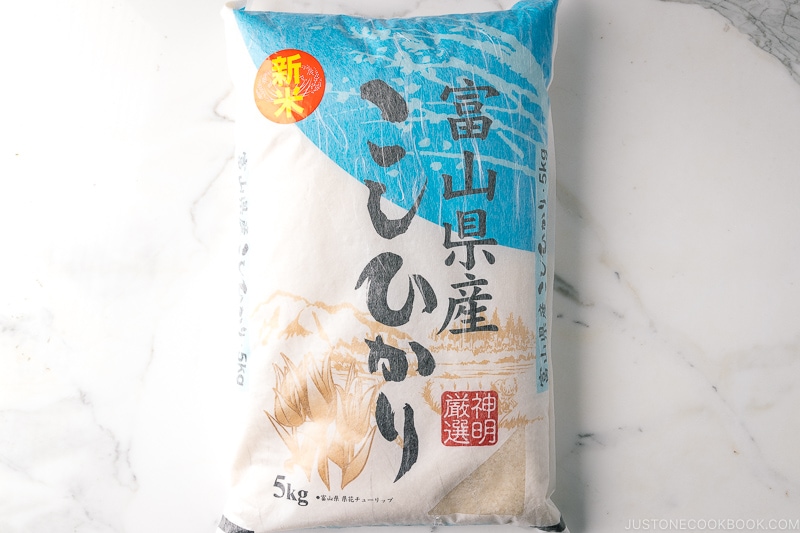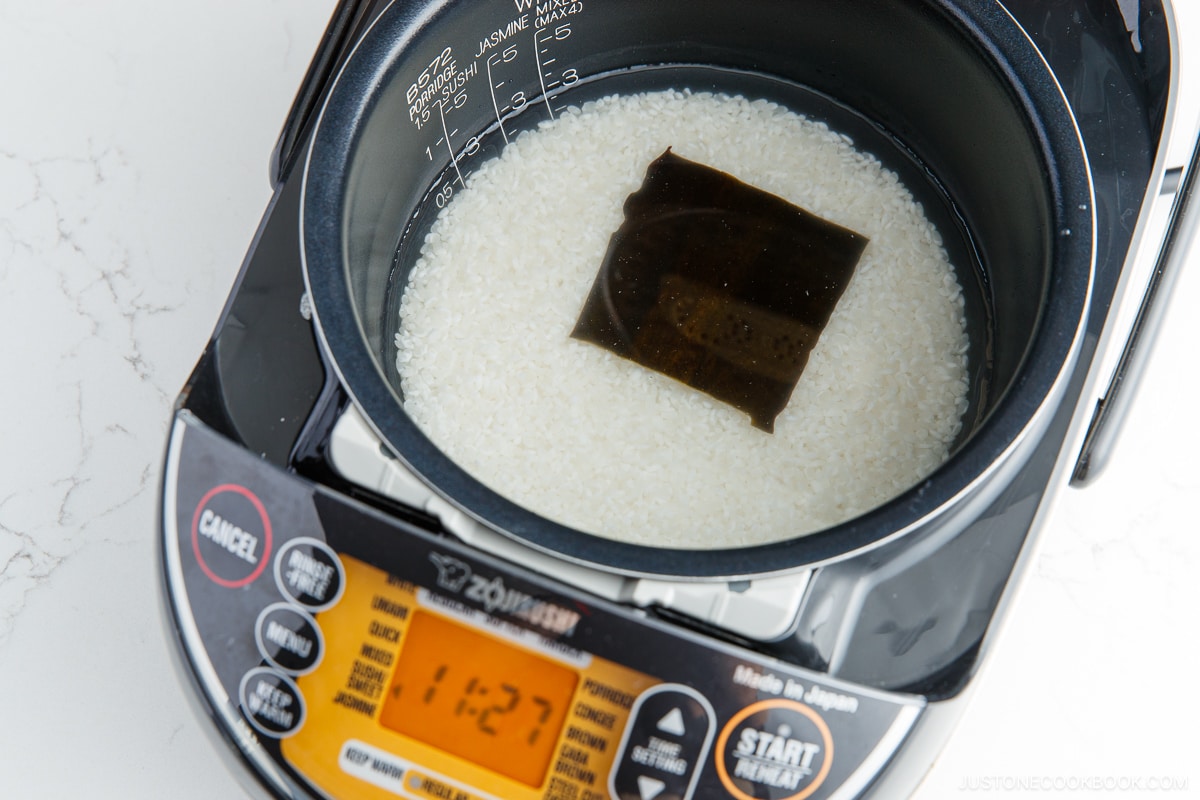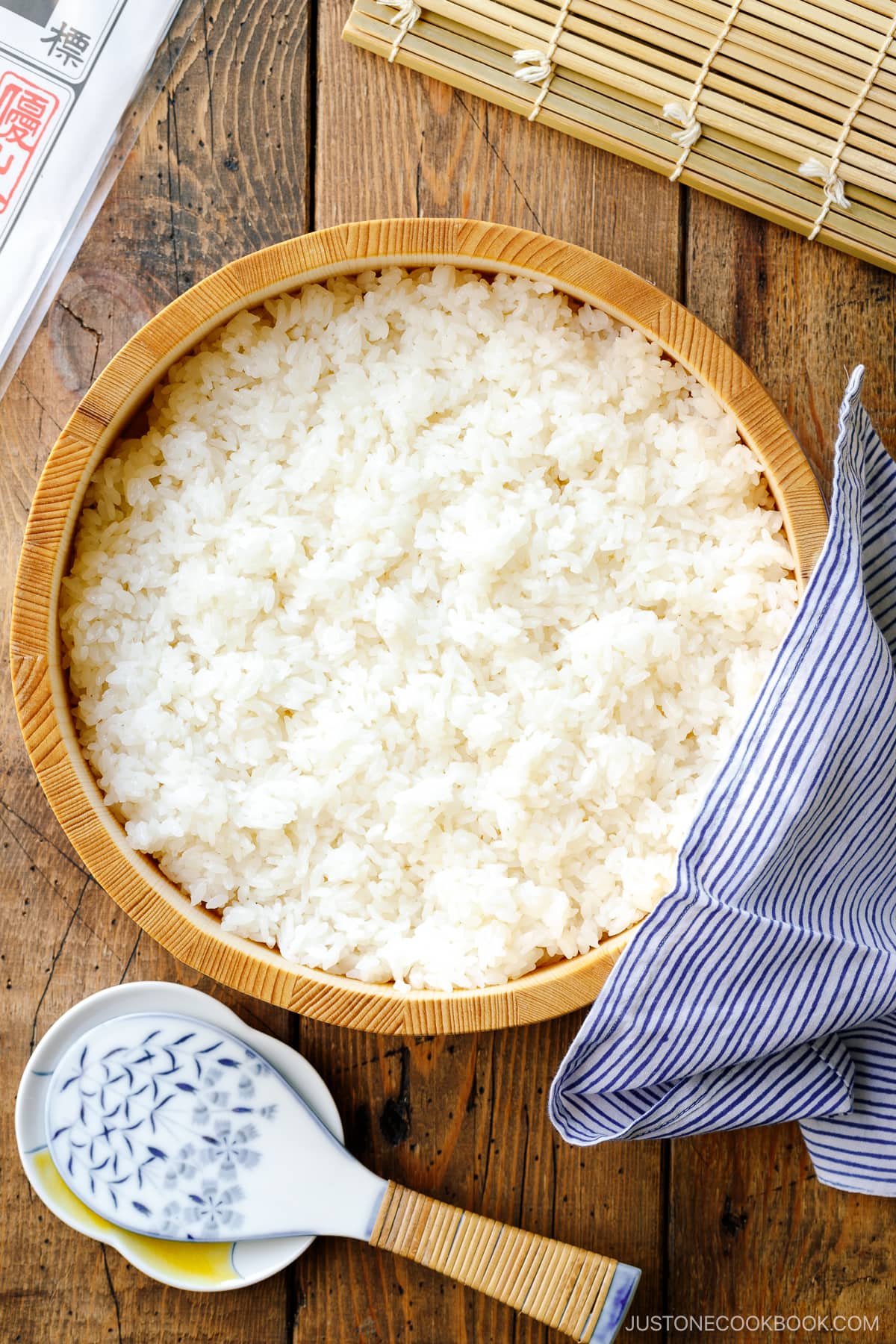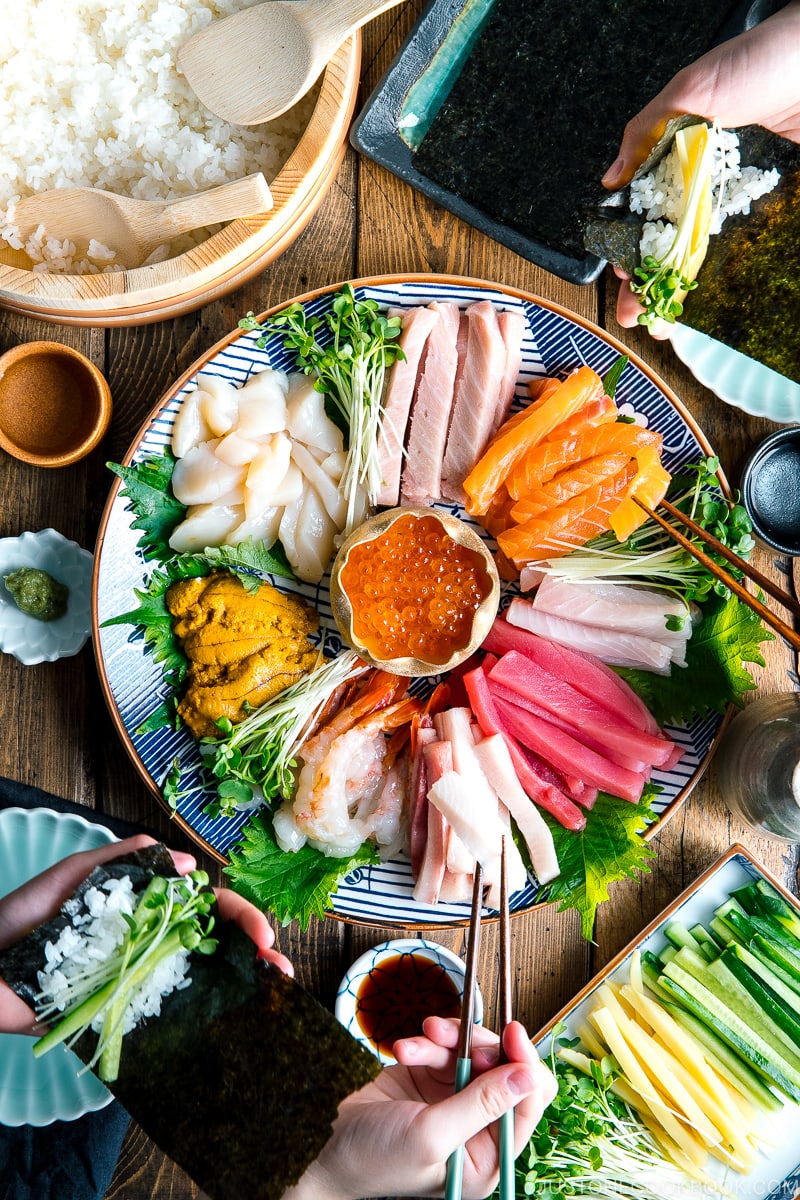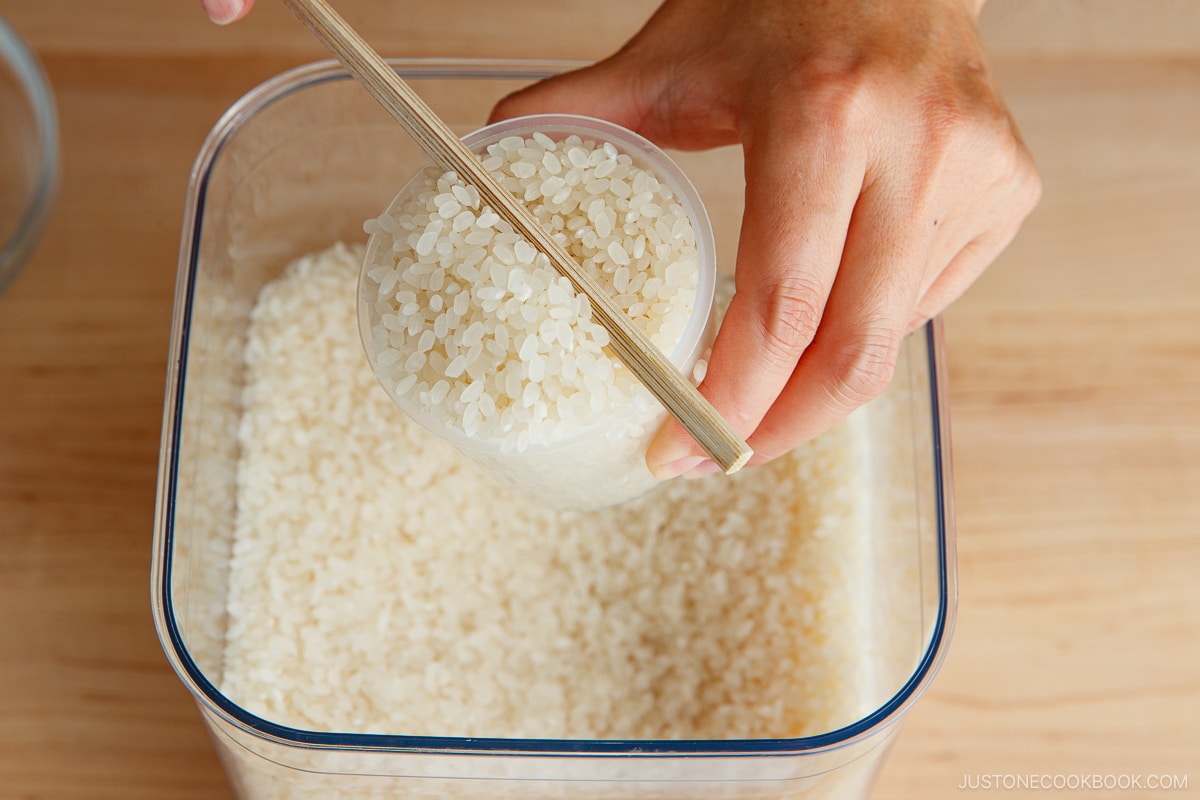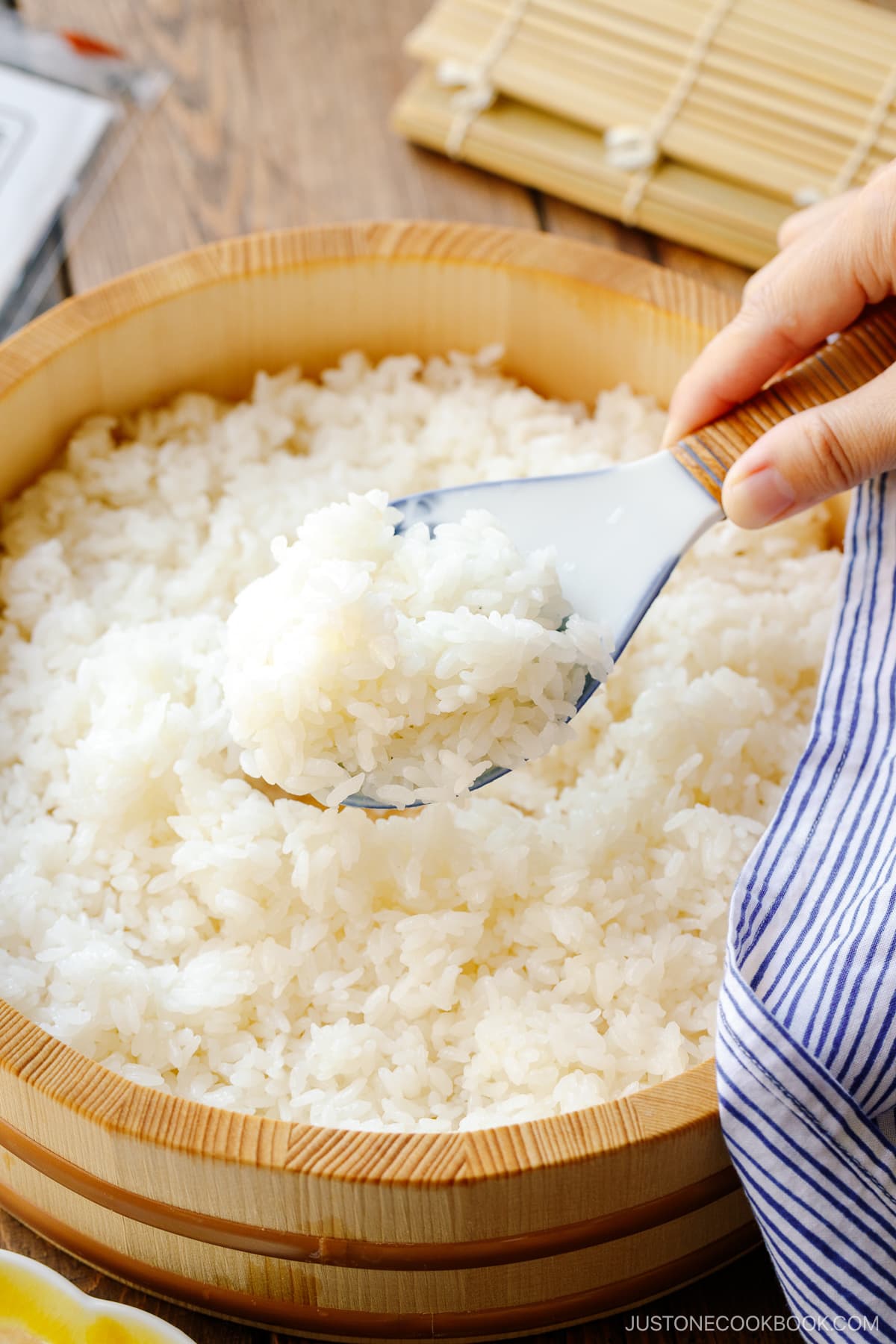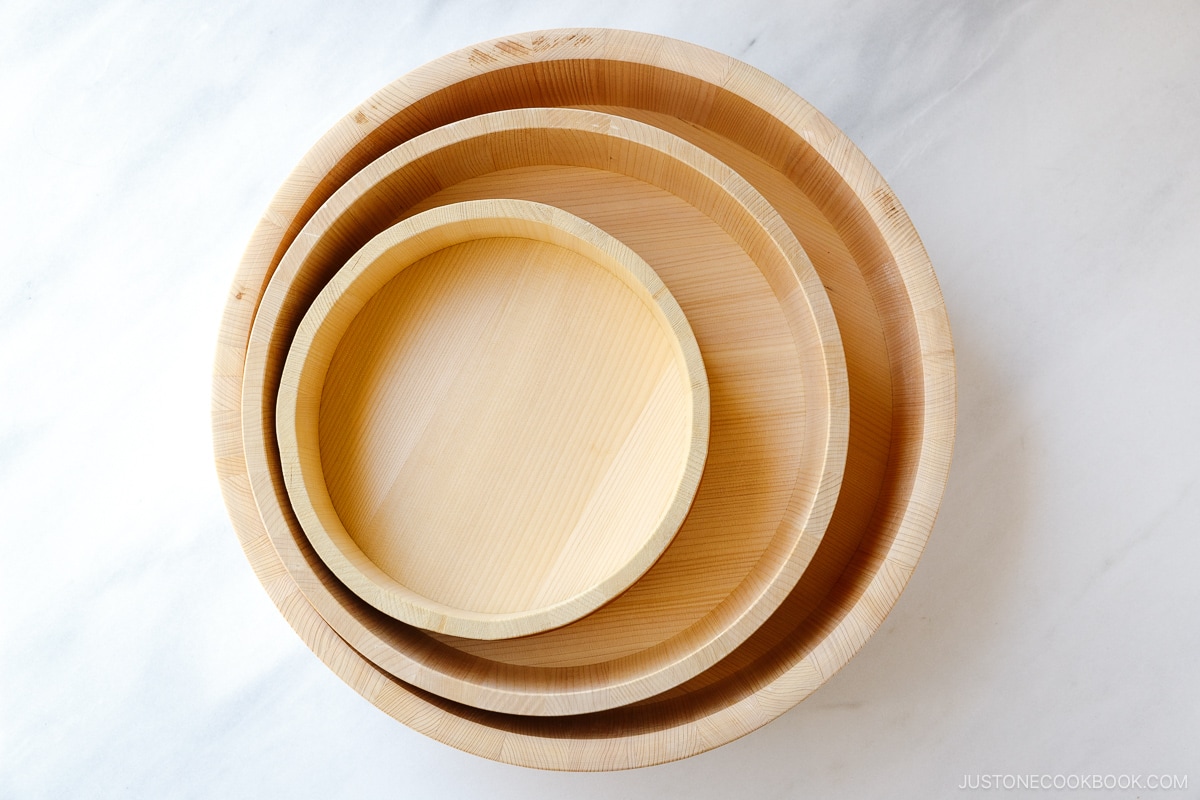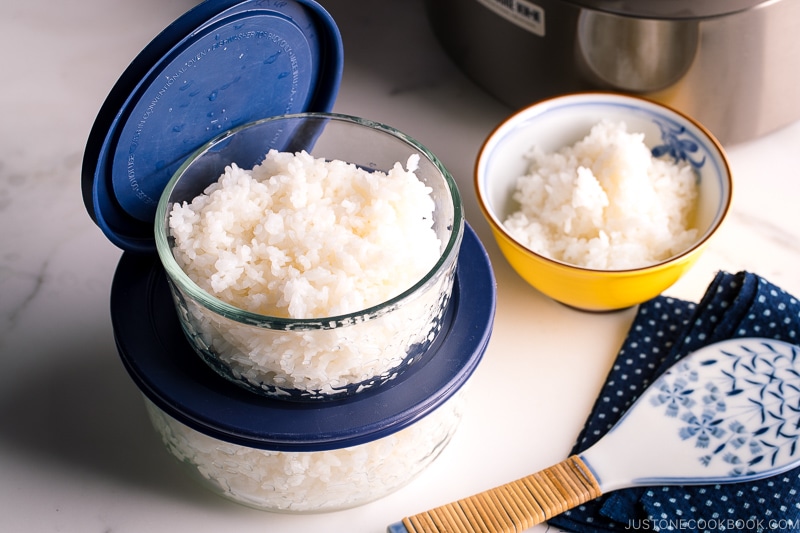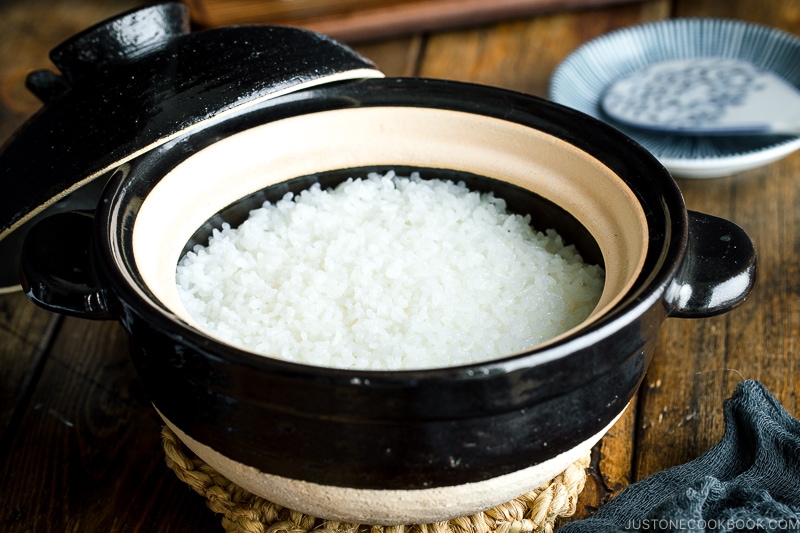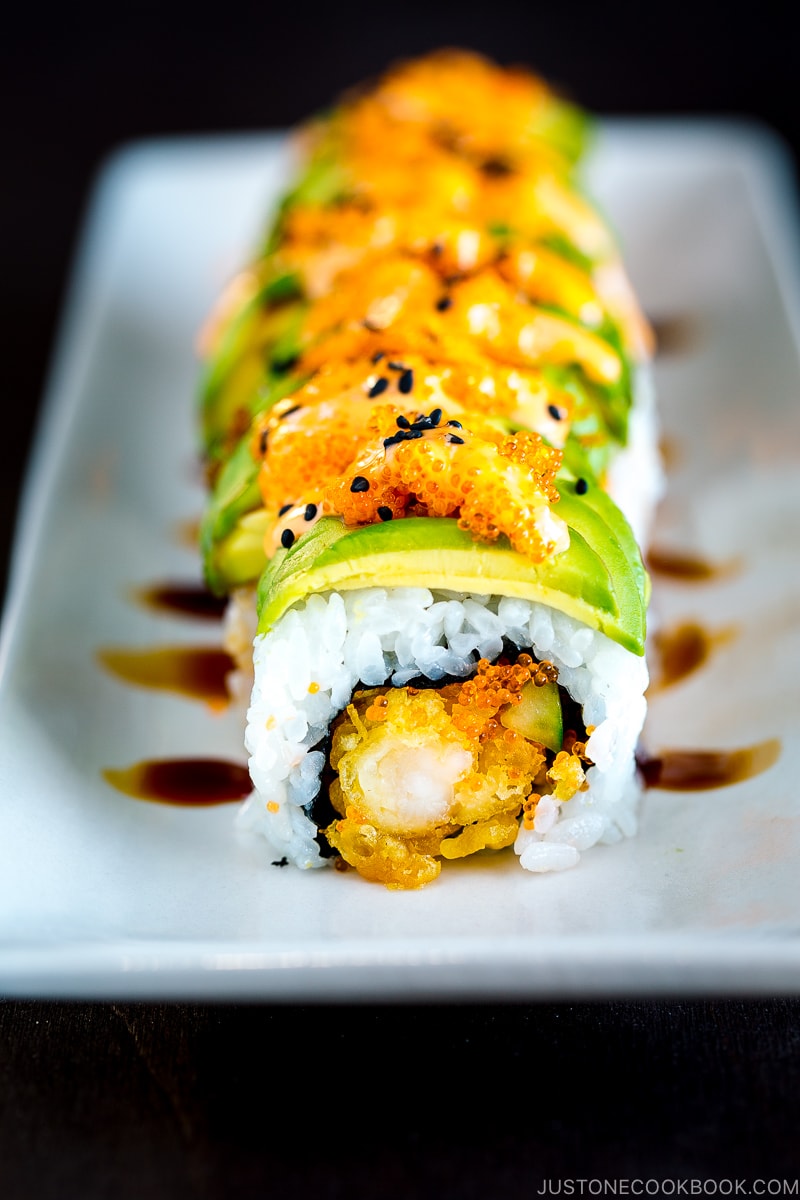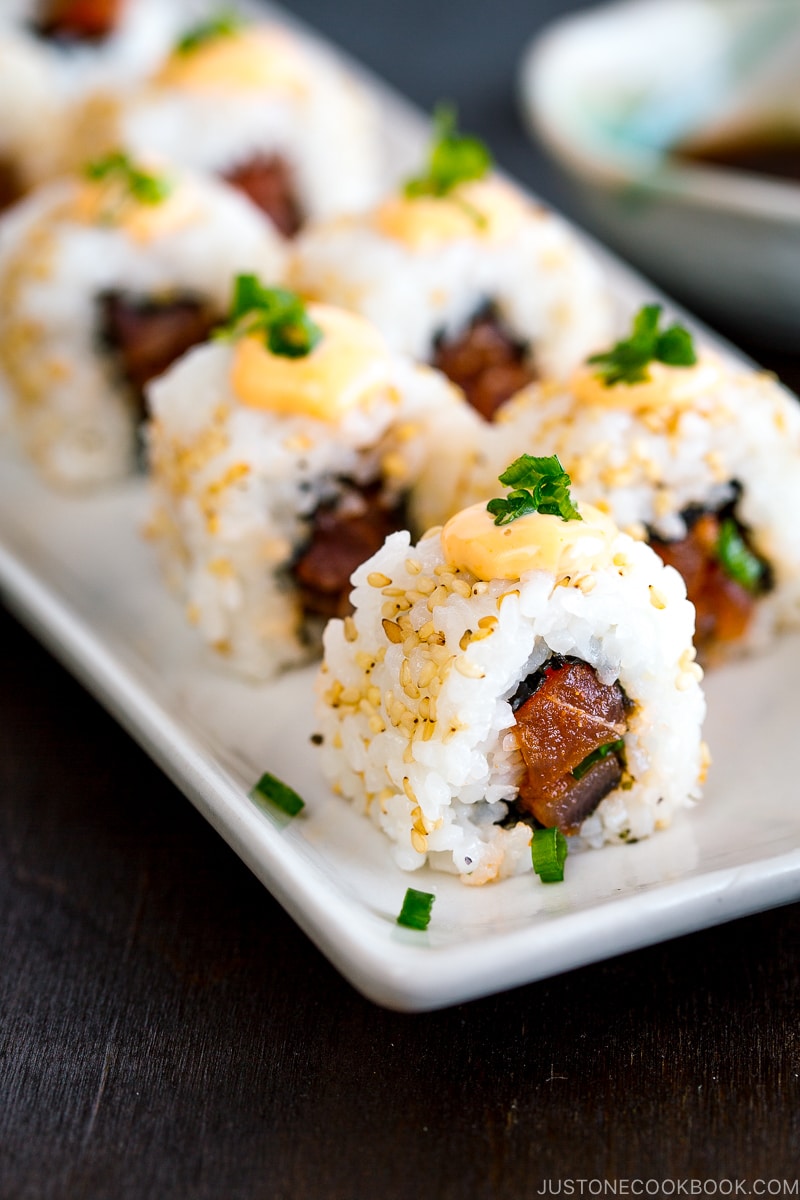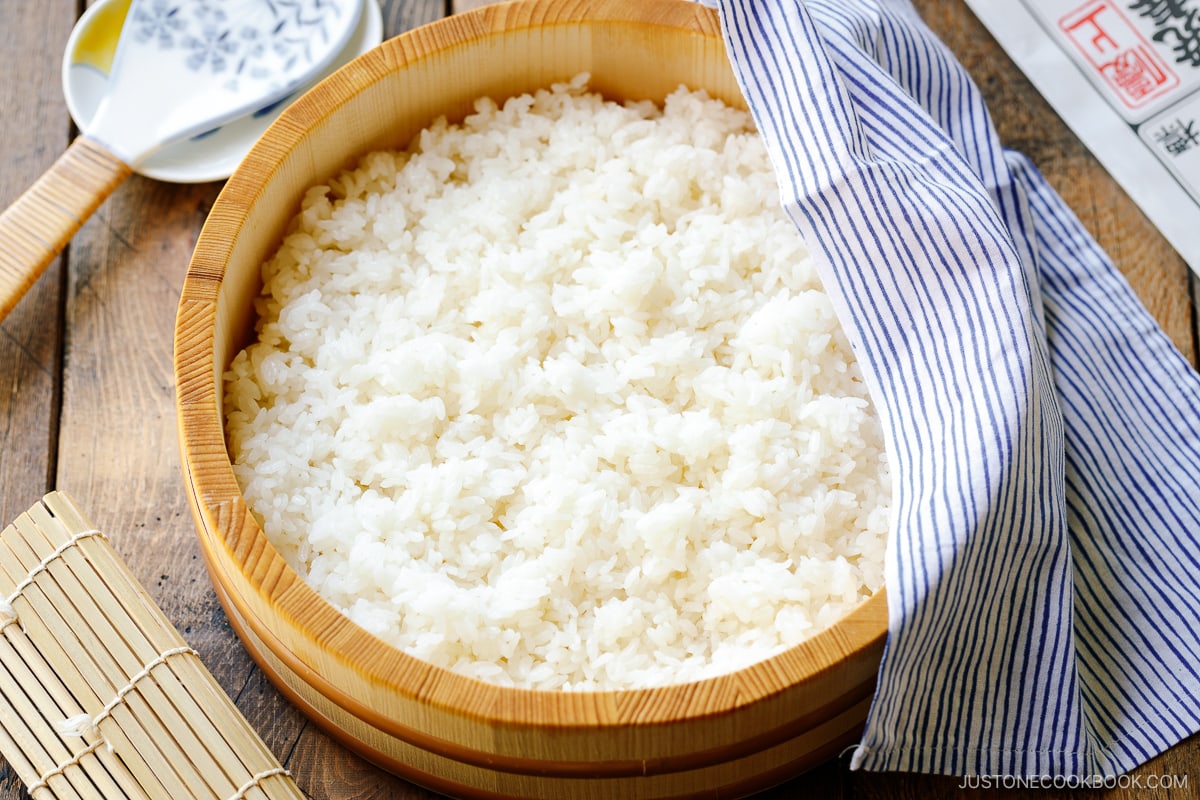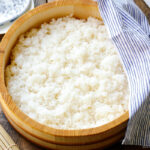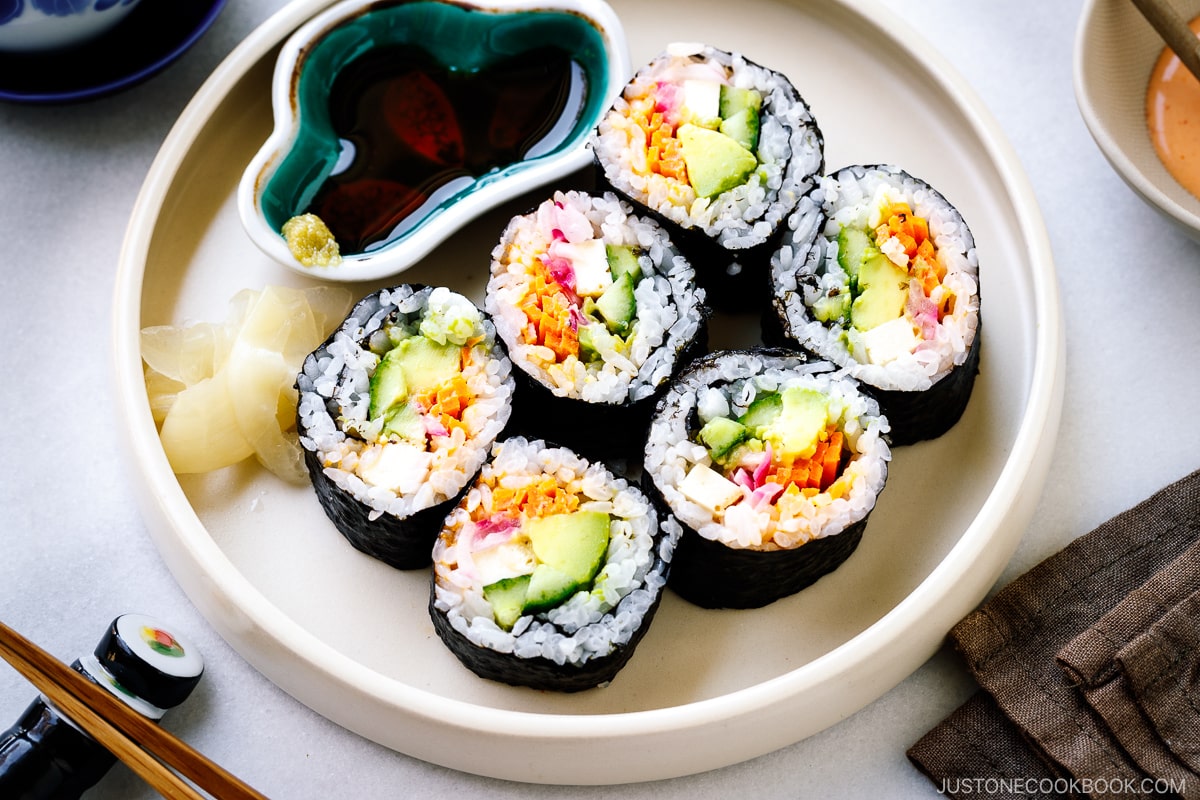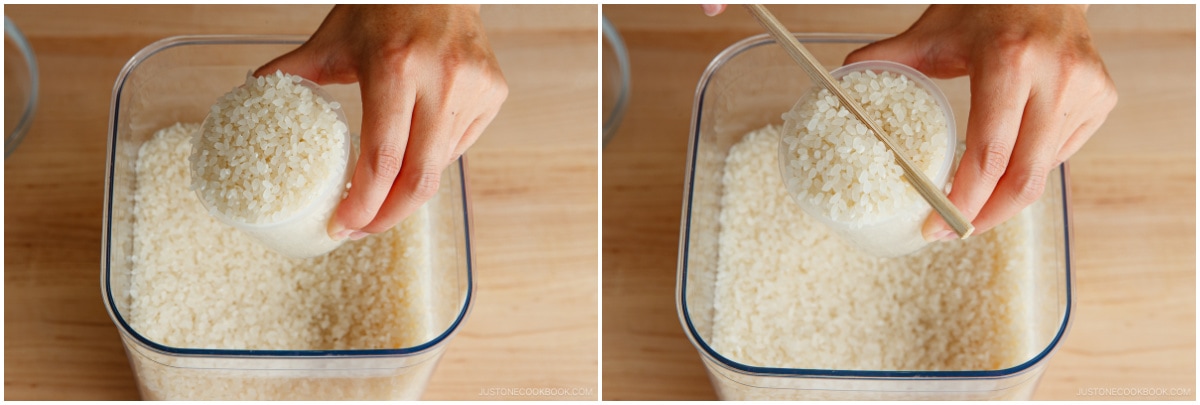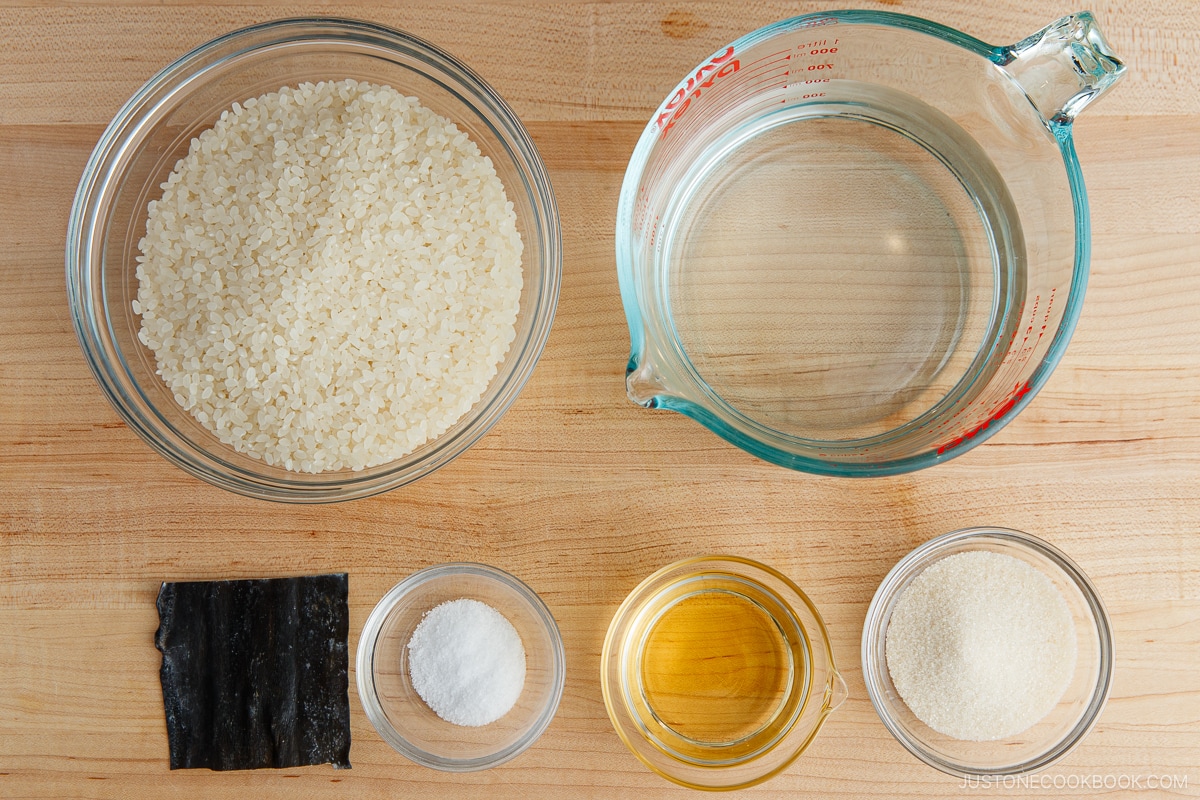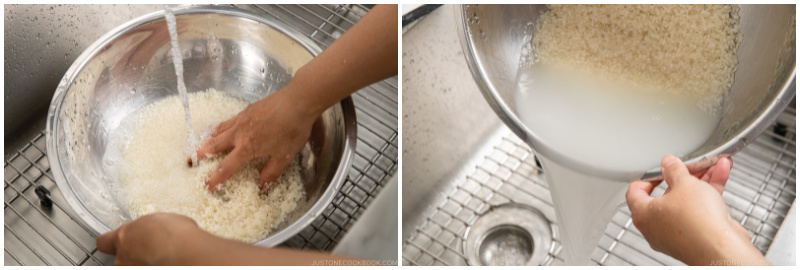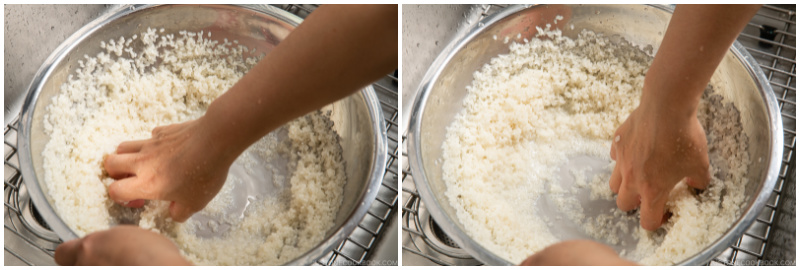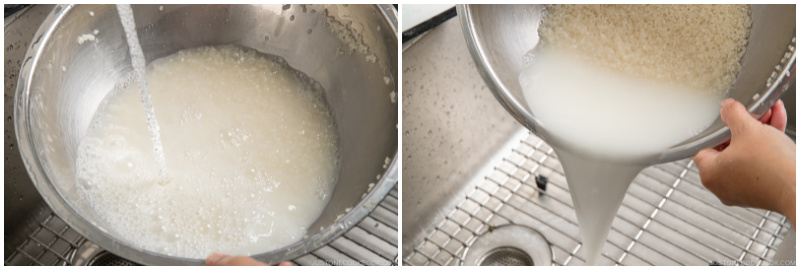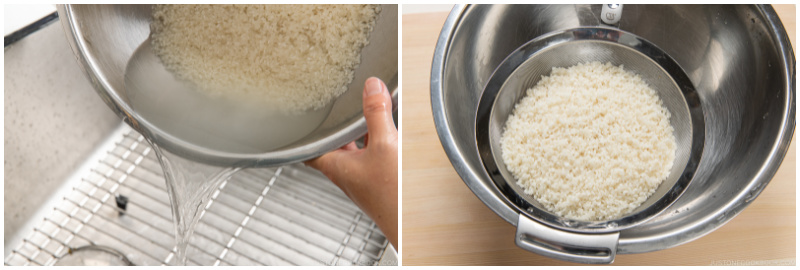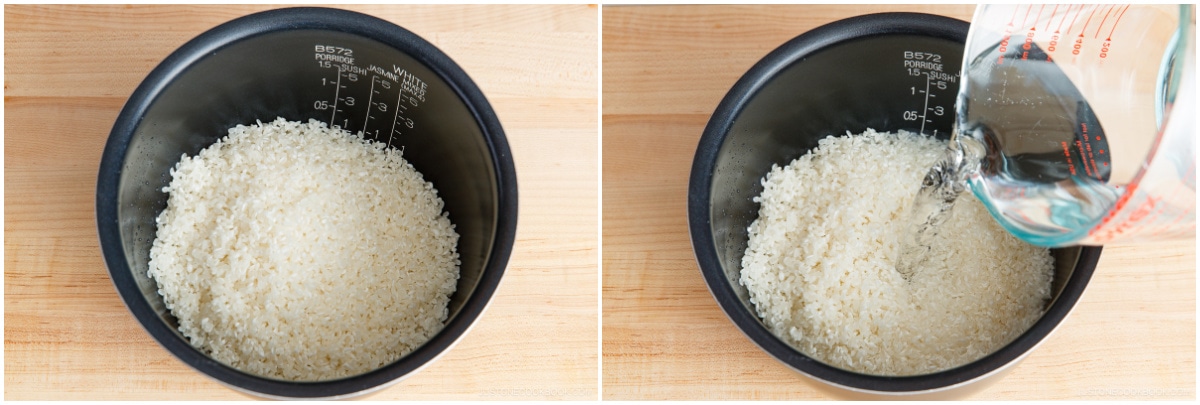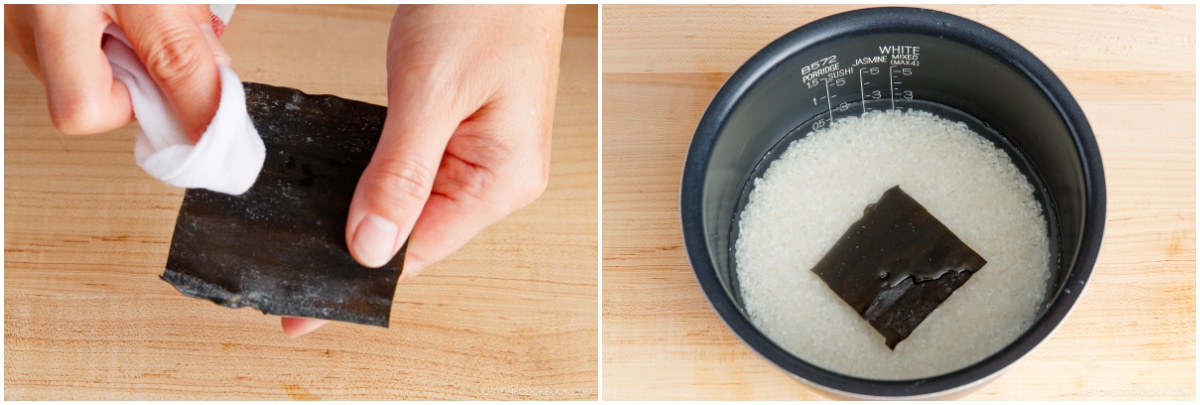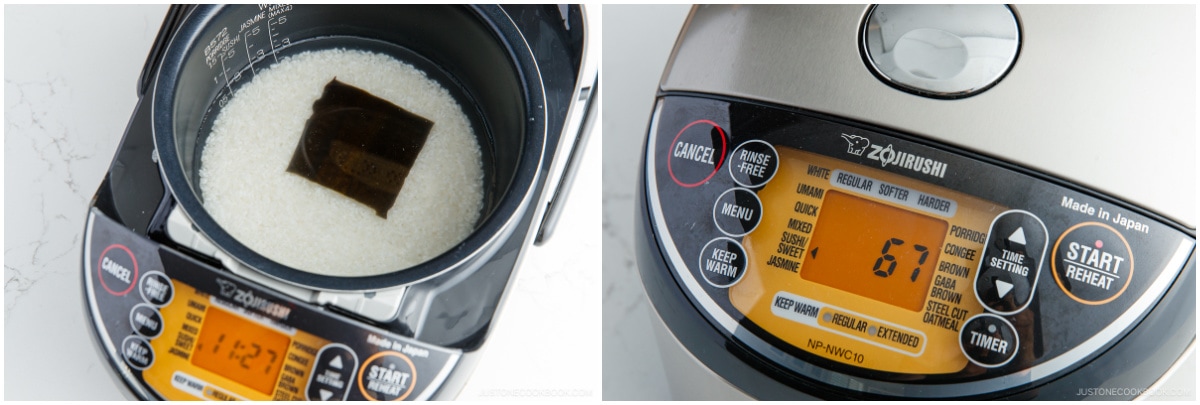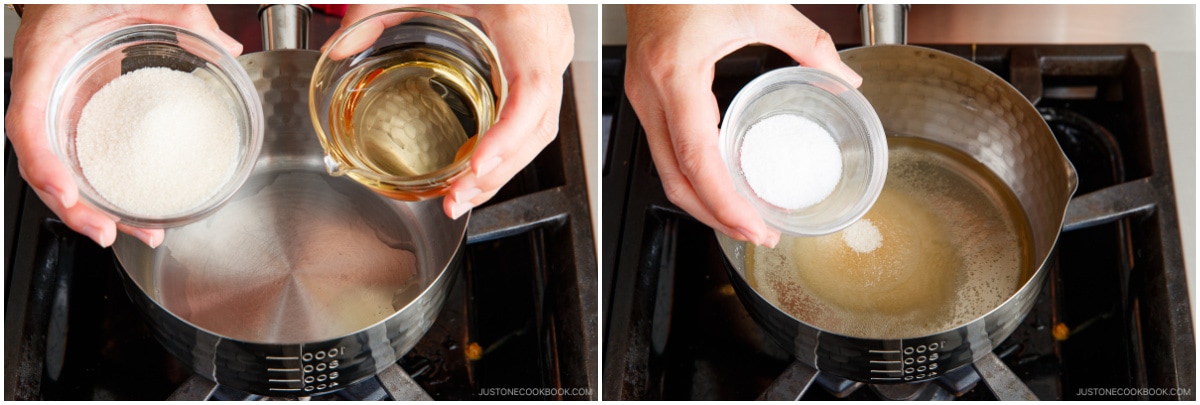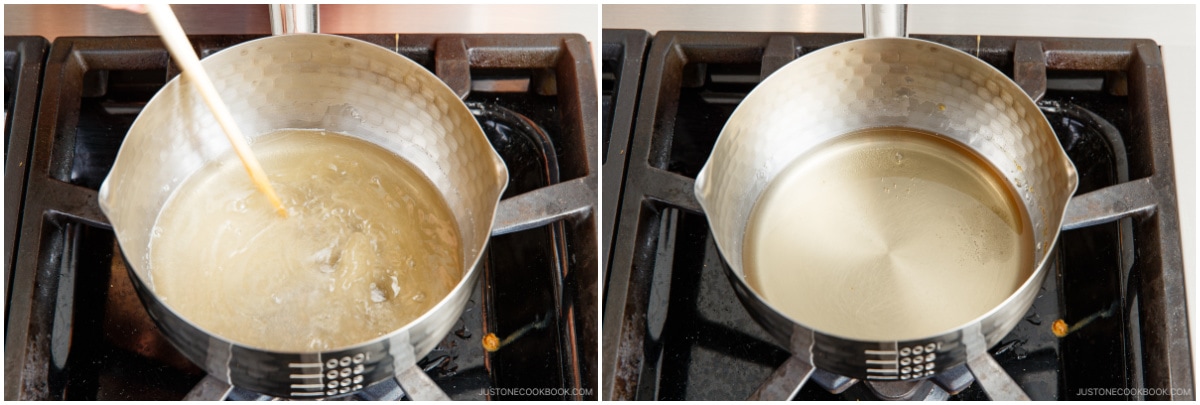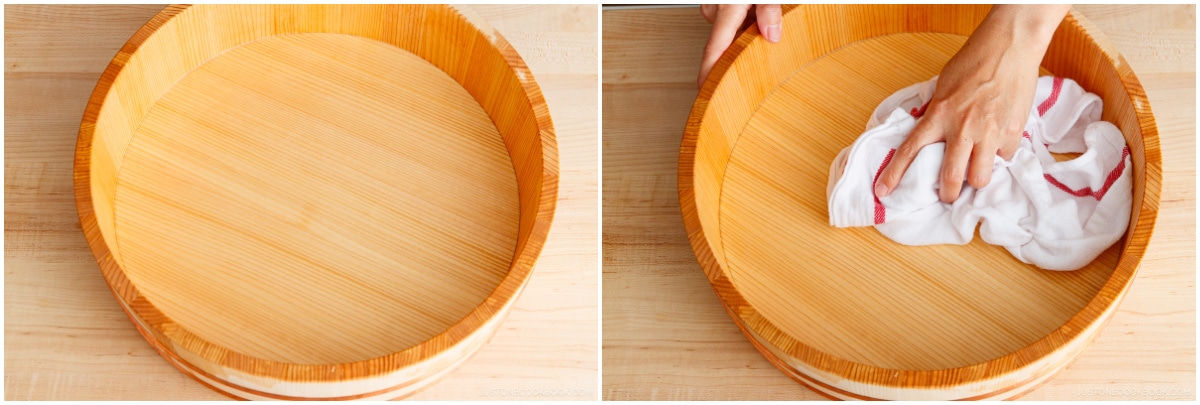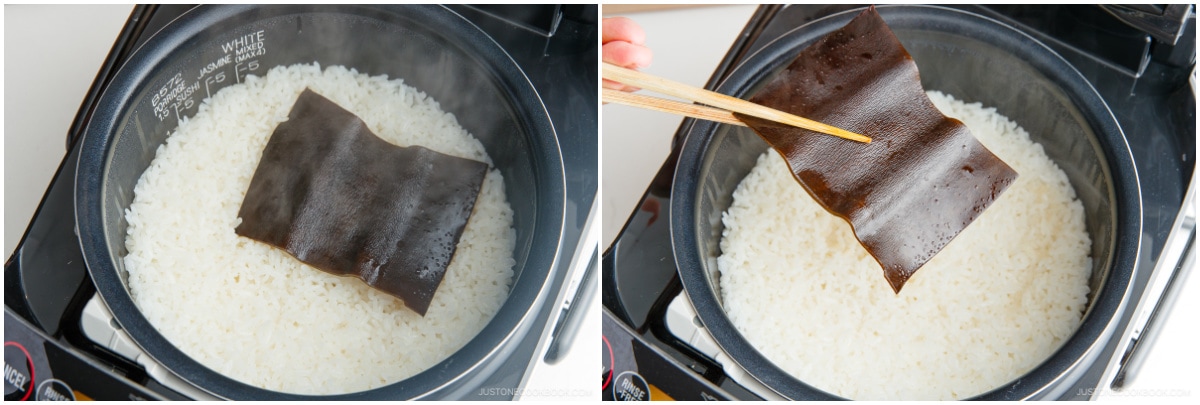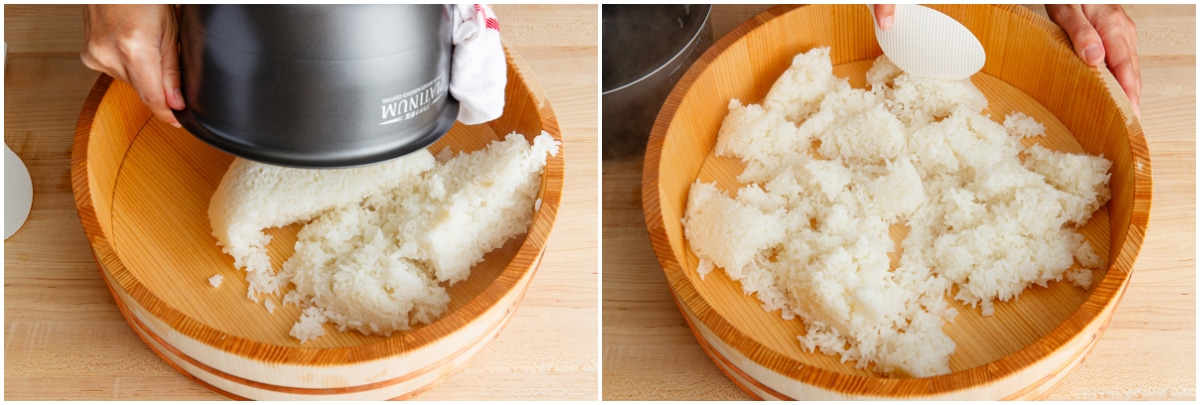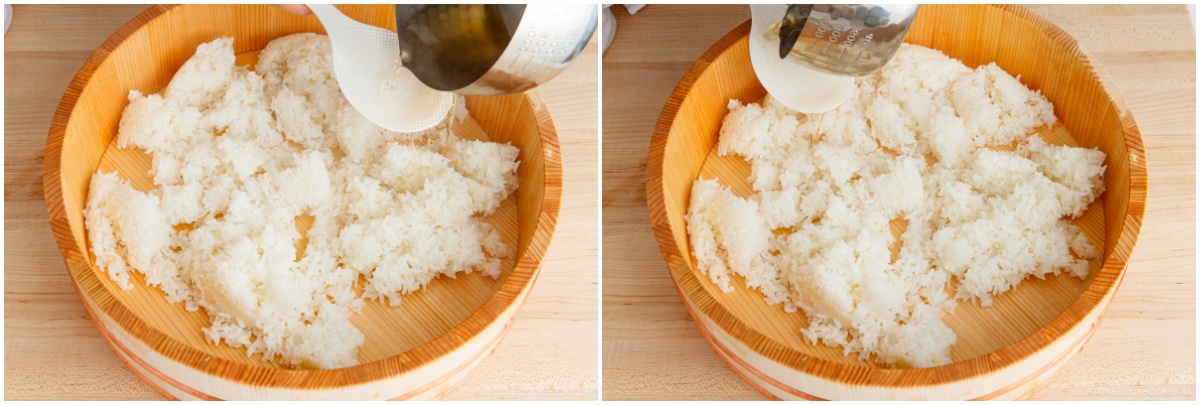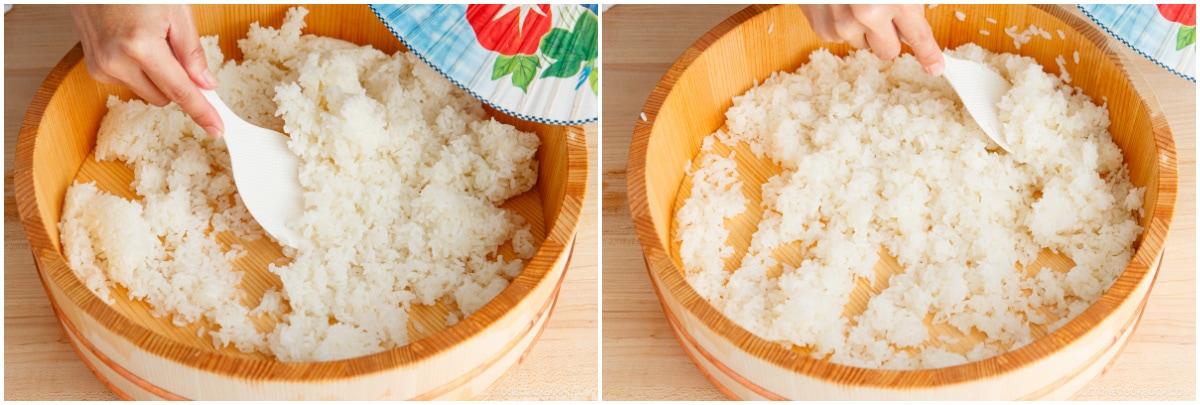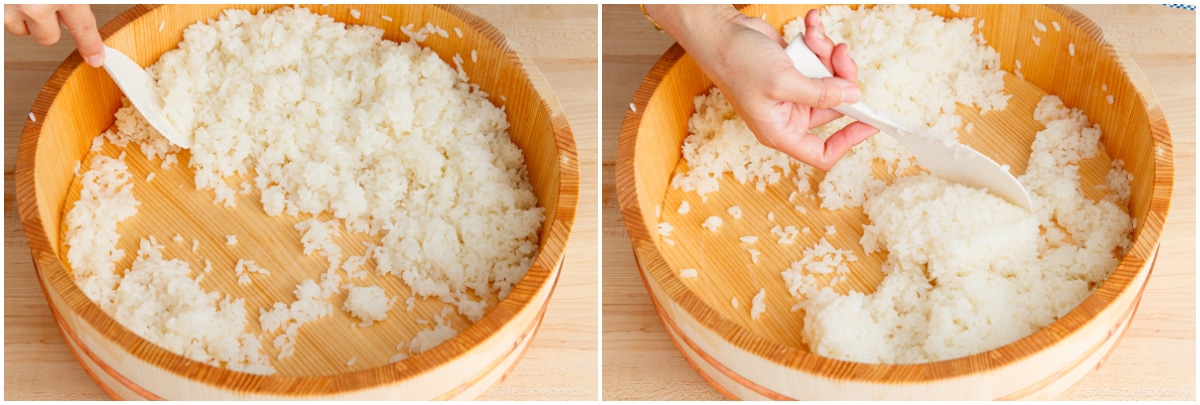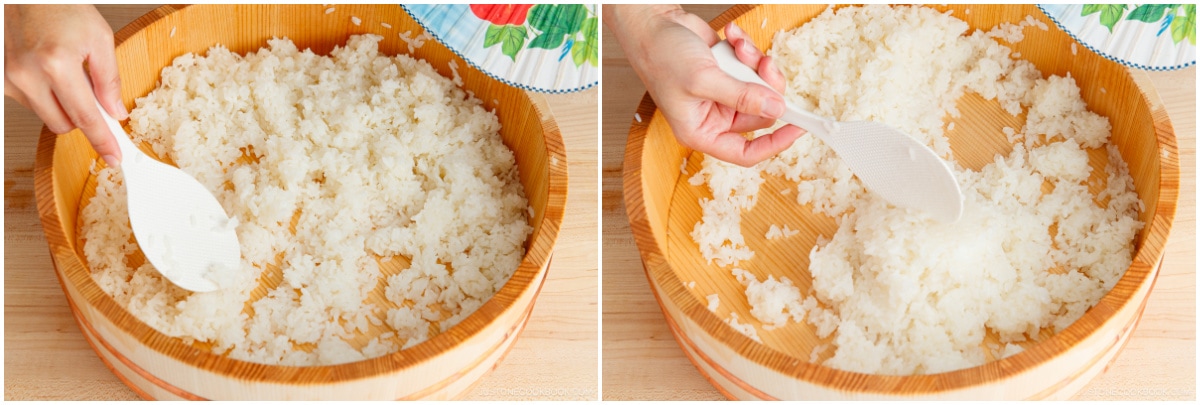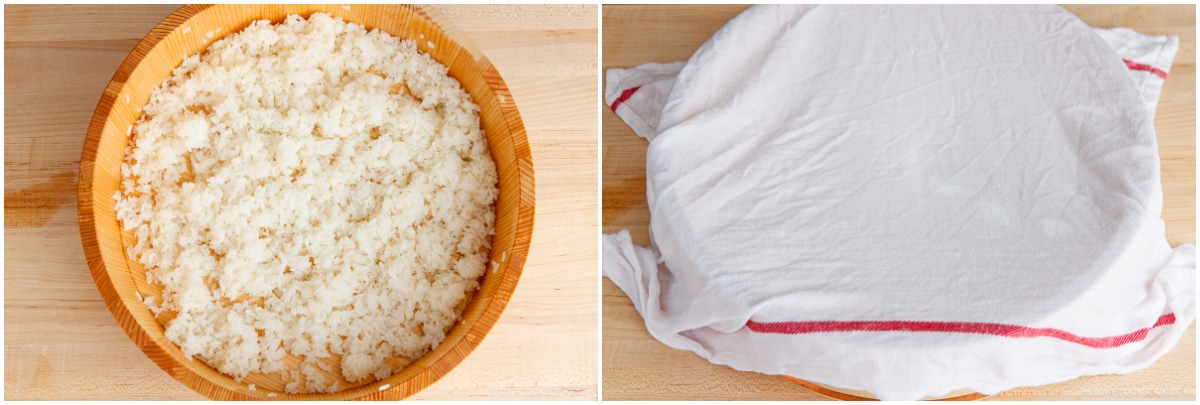Perfectly cooked Sushi Rice (酢飯) is fundamental in making any form of sushi. Indeed, the best sushi restaurants in Japan pride themselves not only on the freshest fish or variety but on the technique and quality of the sushi rice. Here, I shared my secrets and techniques on how to make sushi rice the authentic way. Follow along, and you’ll be able to make the best sushi rice at home for all kinds of sushi!
What is Sushi Rice?
Sushi rice is made by cooking Japanese short-grain rice with kombu (kelp), which is then seasoned with a mixture of rice vinegar, sugar, and salt. In Japanese, sushi rice is also known as sushi-meshi (鮨飯), su-meshi (酢飯), or shari (シャリ). We only use this vinegar-flavored rice when making all kinds of sushi. It’s worth noting that outside of Japan, Japanese short-grain rice is often called “sushi rice” for marketing purposes. In reality, Japanese rice is typically used in everyday meals and less often in sushi recipes. You may also notice that Japanese short-grain rice has been incorrectly called “sticky rice.” Sticky rice is actually another name for glutinous rice or short-grain Japanese mochigome. We use this type of glutinous rice to make Mochi, Sekihan, and Okowa. 👉🏼 If you are here looking for a recipe to make plain steamed rice, see my post on How to Make Rice. 👉🏼 To brush up on your knowledge, I highly recommend reading “Everything You Need to Know about Japanese Rice” and “Types of Japanese Rice.“
Why Do We Season the Steamed Rice with Vinegar?
This actually goes back to the origin of sushi. The literal meaning of sushi is “sour flavor.” Historically, the way people stored fish was by wrapping it in fermented rice. When they were ready to enjoy the fish, the fermented rice was tossed away. Sometime between the 1300s and 1500s, the Japanese slowly stopped using fermented rice and instead added vinegar to the rice to further increase its shelf life. The vinegar ended up improving the flavor of the rice so they started eating the fish and the rice together, which evolved to today’s sushi. These days with refrigeration, there is no longer a spoilage issue with the fish, but the centuries of flavoring the rice with vinegar have become the mainstay.
Where to Buy Japanese Short-Grain Rice
You can find Japanese short-grain rice, commonly labeled as sushi rice, in major grocery stores these days. Some standard, affordable brands like Kokuho Rose and Nishiki are medium-grain rice. For premium brands, I recommend Tamaki Gold and Tamanishiki Super Premium Short Grain Rice, which are available in Asian grocery stores. If you’re looking for imported, high-quality rice from Japan, I would recommend the Koshihikari variety, which is available from various brands at Japanese grocery stores. Known for its sweet taste and fragrance, it is the most popular variety in Japan. My family and I like the Koshihikari rice from Toyama prefecture (see above). Nijiya Market sells it and we think it’s one of the best imported rice available here in the U.S. at this time.
The Right Rice-to-Water Ratio
When cooking rice normally, the Japanese golden ratio for white rice to water is 1 to 1.1 (or 1.2). However, when making sushi rice (for all kinds of sushi recipes), it is very important to leave room for the sushi vinegar to soak into the cooked rice. For that reason, the amount of water to cook the short-grain rice is slightly moderated.
How to Make Perfect Sushi Rice
The Ingredients You’ll Need
Japanese short-grain rice Kombu (kelp) – optional, but it infuses your rice with a nice aroma Rice vinegar Sugar Salt
The Cooking Steps
How Much Rice Do I Need to Cook?
The plastic rice cooker cup that comes with the rice cooker is ¾ cup (180 ml). In Japan, this amount is called ichi go (一合). Also, The rice should be cooked slightly harder and the steaming time should be shortened.
1 rice cooker cup (180 ml, ¾ cup, 150 g) of uncooked rice 2¼ cups or 330 g of cooked rice 1 thick sushi rolls 2 medium sushi rolls 4 thin sushi rolls 3 inside-out rolls 2 rice cooker cups (360 ml, 1½ cups, 300 g) of uncooked rice 4⅓ cups, 660 g of cooked rice 2 thick sushi rolls 4 medium sushi rolls 8 thin sushi rolls 6 inside-out sushi rolls 3 rice cooker cups (540 ml, 2¼ cups, 450 g) of uncooked rice 6⅔ cups or 990 g of cooked rice 4 thick sushi rolls 6 medium sushi rolls 12 thin sushi rolls 9 inside-out sushi rolls 4 rice cooker cups (720 ml, 3 cups, 600 g) of uncooked rice 8¾ cups or 1320 g of cooked rice 5 thick sushi rolls 8 medium sushi rolls 16 thin sushi rolls 12 inside-out sushi rolls 5 rice cooker cups (900 ml, 3¾ cups, 750 g) of uncooked rice 11 cups or 1650 g of cooked rice 6 thick sushi rolls 11 medium sushi rolls 20 thin sushi rolls 15 inside-out sushi rolls
Cooking Tips
Use Japanese short-grain rice. To achieve an authentic Japanese standard, you want to use only short-grain Japanese rice to make sushi rice. This is because the consistency and flavor of Japanese rice are very different from long-grain rice, jasmine rice, or other types of rice. With a higher content of moisture, Japanese rice is characterized by its unique stickiness and texture, which is attributed to the toothsome bite of authentic sushi. Read more about rice on my pantry page. Rinse and soak the rice before cooking. Make sure the rice is washed and rinsed a few times until no more starch comes out from the water. Then let the rice be soaked for at least 20-30 minutes before cooking. This allows the rice grains to yield a better texture. Cook the rice with kombu. Kombu (dried kelp) gives a subtle fragrance and umami taste to the sushi rice. The rice-to-water ratio is 1:1 (volume). Because we add sushi vinegar to the cooked rice, we use a bit less water than when you cook the rice regularly. Make homemade sushi vinegar. Sushi rice is always seasoned with sushi vinegar. It’s made of rice vinegar, sugar, and salt to achieve a balance of sweet, salty, and sour taste. You need to get mild-flavored rice vinegar, not another type of vinegar for this; otherwise, it’s too strong and the flavor is not the same. If you want to save time, you can use a bottle of seasoned vinegar called sushizu (すし酢). Transfer cooked rice to a sushi oke (hangiri), a large salad bowl, or a baking sheet lined with parchment paper. You must let the rice cool fast. It’s common to use an electric fan or hand-held fan called uchiwa (うちわ) to cool the rice. Add sushi vinegar when the rice is hot. As soon as the rice is taken out of the rice cooker or the cooking pot, you have to season the rice with sushi vinegar. Fluff the rice in a slicing motion with a rice paddle. Don’t mix or else sushi rice will end up being mushy or smashed. With proper fanning and slicing, your sushi rice becomes shiny! Cover with a damp towel and keep it at room temp until you’re ready to make sushi.
What Does Perfectly Cooked Rice Look Like?
After the rice is steamed, the rice should be shiny and plump. The texture should be fluffy with a firm bite. And each rice grain should be sticky yet retain its shape. Mushy rice means it has too much water or it is overcooked. If the rice is fresh, you will see a nice shiny gloss on the surface of each grain.
One thick sushi roll (Futomaki) requires 1⅔ cups (250 g) of sushi rice. One medium sushi roll (Chumaki) like Vegetarian Sushi Roll requires 1 cup (150 g) of sushi rice. One thin sushi roll (Hosomaki) requires ½ cup (80 g) of sushi rice. One inside-out sushi roll (Uramaki) like California Roll requires ¾ cup (110 g) sushi rice. One nigiri sushi requires 20 g of sushi rice.
Sushi Oke (Hangiri) – A Wooden Tub
The wooden tub that is used to season, mix, and cool sushi rice is called sushi oke (寿司桶) or hangiri (はんぎり). It has straight edges and a flat bottom, which assists in spreading hot rice and allowing it to cool after adding sushi seasoning. The Hinoki cypress absorbs excess moisture.
Best Way to Store Cooked Rice
What’s the best method to store cooked sushi rice? Simply freeze the sushi rice in airtight containers and bring it back to room temperature when you need it to make sushi! This is by far the best approach to keeping your sushi rice fresh and moist. Do not refrigerate it!
Other Methods of Cooking Japanese Rice
You can cook the rice using a pot over the stove, but the most convenient way is to cook sushi rice using an electric rice cooker. In my Japanese home kitchen, my trusted rice cooker brand is Zojirushi Rice Cooker. Because I cook sushi rice often, this rice cooker has a ‘sushi’ option, which makes it really easy to ensure the rice is cooked perfectly. Here are my recipes for different cooking options.
How to Cook Rice in a Rice Cooker How to Cook Rice in a Pot over the Stovetop How to Cook Rice in an Instant Pot How to Cook Rice in a Donabe
Delicious Sushi Recipes
Now with perfectly cooked sushi rice, you can make all kinds of sushi recipes! If you are interested in learning more, check out my post Learning at Sushi Skills Seminar in San Francisco.
California Roll Dragon Roll Spicy Tuna Roll Yellowtail Tuna Roll (Negihama Maki) Hosomaki (Thin Sushi Roll) Futomaki (Thick Sushi Roll) Chirashi Sushi Saba Oshizushi (Mackerel Pressed Sushi) Inari Sushi Temaki Sushi (Hand Roll) Temari Sushi Mosaic Sushi
Wish to learn more about Japanese cooking? Sign up for our free newsletter to receive cooking tips & recipe updates! And stay in touch with me on Facebook, Pinterest, YouTube, and Instagram. Editor’s Note: This post was originally published on Aug 18, 2011. It was republished with new images, a new video, and more helpful content on January 19, 2024.
